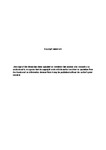INTERACTIONS BETWEEN PORPHYROMONAS GINGIVALIS AND MACROPHAGES IN ORAL PATHOLOGY
| dc.contributor.supervisor | Jackson, Simon K | |
| dc.contributor.author | Belfield, Louise Alicia | |
| dc.contributor.other | Faculty of Science and Engineering | en_US |
| dc.date.accessioned | 2013-09-09T13:52:59Z | |
| dc.date.available | 2013-09-09T13:52:59Z | |
| dc.date.issued | 2013 | |
| dc.date.issued | 2013 | |
| dc.identifier | 375393 | en_US |
| dc.identifier.uri | http://hdl.handle.net/10026.1/1611 | |
| dc.description.abstract |
Macrophages play a fundamental role in driving both inflammatory and immunosuppressive conditions of the oral mucosa. Periodontitis, a chronic inflammatory condition affecting the supporting structures of the teeth, is widely prevalent, affecting a large proportion of the global population, and has been linked to the development of systemic inflammatory diseases. Oral squamous cell carcinoma (OSCC) is placed sixth in the WHO rankings of cancer incidence worldwide, and despite continuing research into underlying mechanisms, incidence is on the rise. Aberrant macrophage function has been implicated in the pathogenesis of both diseases. On recruitment to sites of inflammation, macrophages become polarised within a spectrum of effector phenotypes depending on the factors they encounter in their microenvironment. These cells are highly plastic and continuously adapt their effector functions in response to locally derived stimuli. Mechanisms have been developed by pathogenic bacteria and transformed host tissues to exploit this plasticity and manipulate macrophage phenotype to facilitate disease progression. However, this plasticity is also available for therapeutic manipulation. The main objectives of this study therefore were to investigate the interactions between macrophages and pathogenic stimuli in the context of oral pathology with a view to identifying novel therapeutic targets. Firstly, a reproducible model of M1 and M2 macrophage polarisation using the THP-1 cell line was established to study their interactions with pathogenic stimuli. Treating the cells with combinations of PMA plus IFNγ or IL-4 for 24 hours led to two distinct populations of cells: PMA + IFNγ treated cells expressed higher levels of pro-inflammatory cytokines TNFα, IL-1β and IL-6, but lower levels of IL-10 and TGF-β, characteristic of M1 macrophages. PMA + IL-4 treated cells expressed lower levels of TNFα, IL-1β and IL-6 and higher levels of IL-10 and TGF-β, characteristic of M2 macrophages. As P. gingivalis LPS is present in the developing periodontal lesion, cytokine expression from macrophages exposed to LPS during polarisation was investigated. Exposure of macrophages to 1 μg/ml Pg LPS during polarisation led to a statistically significant down-regulation of inflammatory cytokines TNFα (10-, 4- and 5.5 –fold decrease in PMA, M1 and M2 cells, respectively) and IL-1β (1.9-, 2.0- and 1.5 –fold decrease in PMA, M1 and M2 macrophages, respectively) in response to subsequent stimulation with LPS. IL-6 production was not affected. The same pattern of cytokine down regulation was observed regardless of LPS species used, and in most cases, at a lower dose of 1 ng/ml LPS during polarisation. Finally, as macrophages recruited to the tumour environment will be influenced by tumour-secreted factors, the response of macrophages to LPS stimulation in the presence of OSCC conditioned media was examined. Contrariwise to polarisation with LPS, exposure of macrophages to OSCC produced factors during polarisation led to an amplification of IL-1β (13.8-, 2.3- and 8.8 –fold increase in PMA, M1 and M2 cells, respectively), and IL-6 (16.8-, 17.3- and 44.9 –fold increase in PMA, M1 and M2 cells, respectively), but not TNFα in response to LPS. Counter intuitively, these findings suggest that LPS manipulation of macrophage polarisation might result in a more M2 –like population of cells, whereas OSCC produced factors may result in a more M1- like population of cells. Viewed therapeutically, one short, single exposure of macrophages to LPS would up-regulate pro-inflammatory cytokines, whereas prolonged or chronic exposure would lead to the down-regulation of pro-inflammatory cytokines, therefore, LPS as a therapeutic modulator of macrophage function in an immunosuppressive (M2) environment to an inflammatory environment (M1) would only be viable as a single dose. For chronic inflammatory disease however, a repasted or prolonged exposure of macrophages to LPS skews macrophages to display a more M2-like cytokine profile and could dampen down detrimental pro-inflammatory cytokine production. The continued study of macrophage/ P. gingivalis interactions may shed light on pathogenic mechanisms not only in oral pathological conditions, but in a range of diseases. | en_US |
| dc.language.iso | en | en_US |
| dc.publisher | University of Plymouth | en_US |
| dc.subject | Macrophage | |
| dc.subject | Dental | |
| dc.subject | Immunology | en_US |
| dc.title | INTERACTIONS BETWEEN PORPHYROMONAS GINGIVALIS AND MACROPHAGES IN ORAL PATHOLOGY | en_US |
| dc.type | Thesis | |
| plymouth.version | Full version | en_US |
| dc.identifier.doi | http://dx.doi.org/10.24382/4112 |
Files in this item
This item appears in the following Collection(s)
-
01 Research Theses Main Collection
Research Theses Main


